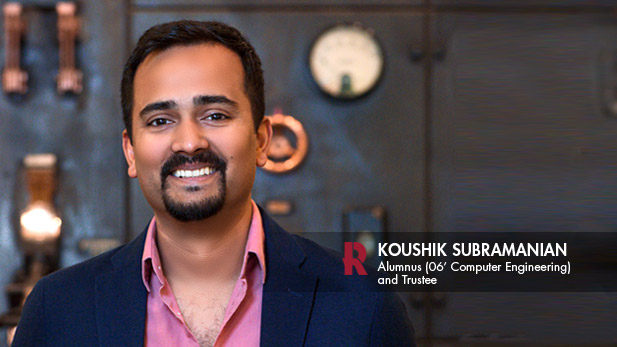Trustee Subramanian Provides Institute’s First Cryptocurrency Gift

A crypto gift from alumnus/trustee Koushik Subramanian to establish the Subramanian Fund for Advancing Technologies in Digital Assets showcases how alumni are finding creative and innovative ways to support the institute.
Koushik Subramanian has spent much of his professional career working in the digital finance space, particularly focused on cybersecurity and more recently in digital assets and blockchain technologies like cryptocurrency, non-fungible tokens (NFTs) and smart contracts.
So it made sense for the 2006 computer engineering graduate, who also serves on Rose-Hulman’s Board of Trustees, to become the first alumnus to give back to Rose-Hulman using cryptocurrency. Subramanian’s $50,000 crypto gift will be used to establish the Subramanian Fund for Advancing Technologies in Digital Assets for the Institute.
“I’m super passionate about this,” said Subramanian, who in 2022 founded drophouse.art to combine his interests in art, fashion and crypto. Two years earlier, he founded Kopper Labs to deploy capital to accelerate the adoption of automation, blockchain and cybersecurity technology. He has worked as Director of Information Security for Kraken since 2018, overseeing cybersecurity and digital assets on a global scale.
“I’ve been fortunate in my career because of my education at Rose to be a thought leader in cybersecurity and digital assets. Knowing what I know now through my career, I have a high degree of confidence that this field is here to stay.”
The form of the gift is the latest example of how Rose-Hulman alumni are constantly finding creative and innovative ways to give back to the top-ranked science, technology, engineering and mathematics-focused institution.
“I truly am looking forward to seeing the impact of Koushik’s gift, both in how it benefits our students and Rose-Hulman long term, but also in how it may help pave the way forward into a world where the possibilities are seemingly endless,” said Rose-Hulman President Robert A. Coons. “Cryptocurrency is just one form of these new technologies, so it will be exciting to see what other new and creative ways our alumni will discover to continue giving back to Rose.”
Rose-Hulman has established a webpage specifically for gifts of digital assets, available at www.rose-hulman.edu/about-us/community-and-public-services/institutional-advancement/crypto.html
Appropriately, Subramanian’s crypto gift will support student learning in the nationally ranked Department of Computer Science and Software Engineering, as well as cross-disciplinary projects involving other majors. Subramanian has been collaborating with Associate Professor of Computer Science and Software Engineering Sid Stamm, PhD, on a number of ideas for senior projects along with other hands-on and research opportunities.
“There are so many options,” Subramanian said. “To start, we can get creative designing senior projects that automate campus-type processes. These projects could step by step, create a blockchain ecosystem on campus that allows for digital credentialing, crypto payments at the bookstore or even tuition, or even NFTs to engage the Alumni community. If we can do that, we’re building a roadmap for the institution to go digital.”
Stamm noted that Subramanian brought “real-world” experiences to the Rose-Hulman campus in 2021 when he visited Stamm’s blockchain elective course.
"Mr. Subramanian's gift is a great help in supporting our cryptocurrency – and generally cybersecurity – educational opportunities,” Stamm said. “As he saw in my blockchain elective last year, students are eager to get exposure to these emerging technologies so that they become prepared for the next big advancement in tech. His generous gift will help us rapidly create new classes and fund interdisciplinary experiences so students can explore, learn, and innovate in this exciting new field."
Subramanian has a goal to educate others about the possibilities related to blockchain technologies, and also some of the misnomers.
“I think this is an opportunity to elevate Rose-Hulman into this space ahead of its peers and help Rose become a leader in digital assets,” he added. “It allows us to bring more STEM talent to the Midwest and allows Rose to build out more programing. Plus it allows me to work with students who are engaged in the subject matter. There is tremendous potential in the space to solve real-world problems at scale and I believe we are still very early. I am really excited to see how this technology gets applied by the coming generation.”